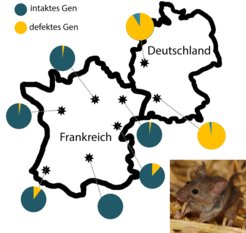Natural gene therapy for house mice
Western house mice in France have cured a genetic defect by taking up an intact gene from the eastern house mouse.

Extensive DNA sequence comparisons with worldwide samples from house mice at the Max Planck Institute for Evolutionary Biology in Plön have shown that a genetic defect in the amylase gene of the subspecies of the western house mouse could be "cured" by taking up an intact gene of the eastern house mouse. The research work on the house mouse will be presented on 7.11. at 16 o'clock in the context of the program "W wie Wissen" (ARD).
Amylase is an enzyme which is necessary for the splitting of starch in food. It is produced in both saliva and the pancreas. When the western house mouse (Mus m. domesticus) colonized Western Europe about 3000 years ago, the founding population brought a genetic defect in an amylase gene with it. These mice had a mutation in the amylase of the pancreas that made the gene inactive. However, the amylase in saliva was apparently sufficient to successfully spread throughout Western Europe.
Researchers at the Max Planck Institute for Evolutionary Biology in Plön have now discovered that the mouse populations in France once again possess an intact gene for amylase in the pancreas. By DNA sequence comparisons with worldwide samples of house mice, they were able to show that this intact gene originates from the eastern house mouse (Mus m. musculus). The two house mouse lines separated about 500,000 years ago, which, due to the short generation times of mice, corresponds approximately to an evolutionary distance between humans and gibbons. So they are actually different species, but they can still mate. In the process, genes can be transferred from one species to another.
In the case of amylase, an eastern house mouse with the intact gene probably arrived by ship in southern France. This gave an additional advantage to the western house mice, which "snapped it up", so that the intact variant spread very fast over France and meanwhile can also be detected in some populations in Germany.
Genetic modification took place only a few hundred years ago
The enforcement of an advantageous gene variant leaves characteristic traces in the genome around the gene, so-called "selective sweeps". These are characterized by a loss of normal variation in the affected genome segment, as the original variants are replaced by the new one. The researchers from Plön could prove that the "selective sweep" around the amylase is one of the strongest in the whole genome, i.e. the intact gene arrived in Western Europe only a few hundred years ago. Similar gene transfers between species have been found more often, including between humans and Neanderthals. In this case, the special feature is that the defective amylase gene has been replaced by an intact one. The mating between two mouse species has thus led to a natural gene therapy.
